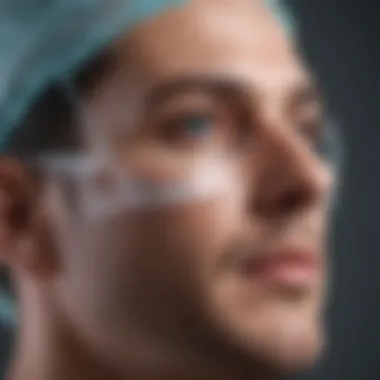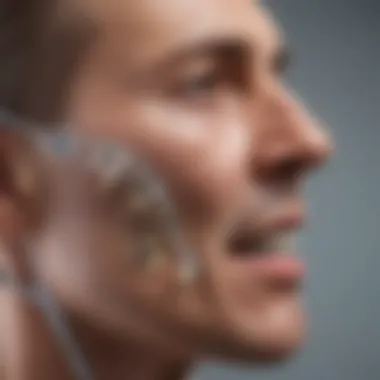Understanding the Maxillofacial Shield: A Comprehensive Overview


Intro
The maxillofacial shield serves as a pivotal instrument within medical practices, particularly relevant in maxillofacial surgery. Understanding this device requires an exploration of its design, use in clinical settings, and implications for patient health. This overview aims to clarify the integral role that the maxillofacial shield plays in ensuring safety and enhancing outcomes for patients undergoing facial or jaw procedures.
As we dissect the various dimensions of the maxillofacial shield, it is important to appreciate its multifaceted nature. From its development to current applications in surgery, the shield illustrates a significant advancement in medical technology. By investigating key aspects of this device, we hope to provide clarity on its function and importance in the evolving landscape of surgical practices.
Key Concepts
Definition of Primary Terms
To fully grasp the concept of the maxillofacial shield, we first define relevant terminology. The term maxillofacial refers to the area of the face and jaw. The shield is a protective apparatus designed to safeguard sensitive structures during surgical operations, particularly in maxillofacial interventions.
Related Concepts and Theories
The application of the maxillofacial shield is closely linked to various theories in surgical practice and patient care. Some related concepts include:
- Infection Control: The shield reduces potential exposure to pathogens during surgery.
- Patient Safety: It minimizes risks associated with surgical procedures.
- Technological Advancements: Ongoing developments in materials and design continue to enhance its effectiveness.
These concepts collectively inform the understanding of the maxillofacial shield's purpose and utility.
Applications and Significance in Surgical Contexts
The maxillofacial shield finds utility in a range of surgical contexts. Its primary application is in protecting the facial and oral regions during invasive procedures. This device plays a measurable role in attaining favorable outcomes, thereby impacting patient recovery and satisfaction. Additionally, its significance extends beyond surgery, influencing preventive measures in various medical environments.
In particular, the maxillofacial shield is beneficial in managing risks associated with surgical instruments and contamination. It provides a barrier that can prevent debris and fluids from affecting the surgical site. Thus, it upholds sterility, a critical component in surgery.
Future Directions
Gaps Identified in Current Research
Despite the advancements surrounding the maxillofacial shield, gaps in research exist. Limited studies address long-term outcomes associated with the use of the shield in diverse surgical populations. There’s a need for comprehensive data that considers varying patient demographics and surgical complexities.
Suggestions for Further Studies
Further exploration should focus on:
- Longitudinal studies assessing the long-term efficacy and safety of the maxillofacial shield.
- Innovations in materials to enhance protective features.
- Comparative studies analyzing outcomes based on different types of shields used in clinical practice.
The ongoing evolution of medical technologies necessitates continuous research to refine protective devices like the maxillofacial shield. Such investigations will ultimately lead to improved patient care and safety.
Preamble to the Maxillofacial Shield
The maxillofacial shield is a specialized device integral to various medical practices, particularly in procedures concerning the face and jaw. Its significance cannot be overstated in both surgical and non-surgical environments. Understanding the maxillofacial shield involves looking at its design, functionality, and the overarching benefits it provides in clinical settings. This article aims to dissect these layers, offering readers a nuanced view of the shield's role.
The importance of the maxillofacial shield is highlighted by its protective capabilities. It not only safeguards sensitive anatomical structures during surgical interventions but also enhances patient comfort, thereby improving overall satisfaction with medical care. By mitigating risk, it contributes positively to patient outcomes, making it a critical component in the toolkit of healthcare professionals involved in maxillofacial procedures.
Defining the Maxillofacial Shield
The maxillofacial shield is defined as a protective device designed to cover the facial region, particularly during surgical operations and radiation therapies. It is engineered to absorb and distribute impact forces, while also shielding the skin and underlying tissues from external hazards.
In essence, this shield acts as a barrier, protecting vital anatomical elements such as nerves, blood vessels, and the intricate bone structures of the face. By doing so, it plays an essential role in minimizing complications that may arise from procedures involving delicate facial areas.
Historical Context and Evolution


The evolution of the maxillofacial shield traces back several decades, when medical professionals first recognized the need for enhanced protection during facial surgeries. Initially, rudimentary materials were used, which often failed to provide adequate patient safety or comfort.
As technology progressed, so too did the design and materials utilized in creating these shields. Innovations in materials science have led to the integration of lightweight, durable materials that enhance both protection and comfort. From metal shields to advanced polymers, the journey of the maxillofacial shield reflects broader trends in medical technology and patient care practices.
Furthermore, historical analysis shows how advancements in medical imaging have also influenced the design of these shields, allowing for greater precision in tailoring them to individual patient needs. The continuous assessment and iteration of design has been crucial for improving safety in surgical outcomes, placing the maxillofacial shield as an essential element in modern healthcare.
Anatomical Considerations
The maxillofacial region is crucial in understanding the efficacy and application of the maxillofacial shield. The unique structure of this area, which includes the jaw, cheeks, nose, and eyes, presents specific challenges in surgical and protective practices. A thorough examination of its anatomical features not only enhances surgical precision but also promotes better patient outcomes.
Structure of the Maxillofacial Region
The maxillofacial structure comprises several important bones and tissues. This includes the maxilla, mandible, zygomatic bones, and nasal bone. The architecture of this region is intricate and plays a significant role in both functional and aesthetic aspects of the face. For instance, the mandible's mobility allows for critical functions like chewing and speaking, underscoring the need for protective devices during surgical interventions.
Understanding this anatomical layout helps in designing shields that conform well to the patient’s facial contours. A well-fitted shield is essential for safeguarding sensitive areas during procedures such as orthodontics or trauma surgery. The fit and comfort of the shield can minimize the risk of post-operative complications and enhance overall patient experience.
"The detailed understanding of facial anatomy is fundamental for successful surgical interventions, especially when employing protective devices."
Impact of Trauma on Facial Anatomy
Trauma to the maxillofacial region can lead to significant alterations in anatomy, functionality, and aesthetics. Injuries from accidents, falls, or violence can fracture bones, tear tissues, and distort facial symmetry. This resultant trauma necessitates careful reconstruction and protection, marking the importance of the maxillofacial shield.
When trauma occurs, the natural defenses of the body are often compromised. The shield serves as a barrier to further injury during surgeries that may involve complex reconstruction, like that necessary after a vehicular accident. Not only does it protect against external forces, but it can also provide psychological comfort to patients undergoing treatment for facial injuries.
In cases of severe trauma, timely and well-planned surgical responses are essential. This highlights the need for thorough pre-operative assessments and customized shield designs. Therefore, understanding both the structural and functional implications of trauma is essential when considering the deployment of a maxillofacial shield in medical practices.
Design Features of the Maxillofacial Shield
The design of the maxillofacial shield plays a critical role in its effectiveness and utility in medical practice. This section examines the specific elements that constitute the design features of the maxillofacial shield. Understanding these features highlights their benefits and considerations in various medical contexts. A well-designed shield not only facilitates successful surgical outcomes but also enhances patient comfort and safety.
Materials Used in Construction
The materials selected for the construction of maxillofacial shields are paramount to their functionality and durability. Common materials include high-density polyethylene, polycarbonate, and thermoplastic elastomers. Each material has its own set of advantages, impacting weight, flexibility, and clarity.
- High-Density Polyethylene (HDPE): Widely used for its strength and resistance to impact. HDPE also balances cost and performance, making it a popular choice.
- Polycarbonate: Known for its superior clarity and high impact resistance. This material aids in visibility during surgical procedures.
- Thermoplastic Elastomers: These materials provide flexibility and comfort, making them suitable for prolonged wear.
The choice of material affects the overall performance of the shield. The design must ensure that it can withstand significant stress while providing adequate protection to the maxillofacial region.
Customization and Precision Fitting
Customization of the maxillofacial shield is essential to ensure precise fitting for each patient. Custom shields take into account the unique anatomical features of the individual, leading to better protection and comfort.
Precision fitting involves several steps:
- Assessment of Anatomy: Initial evaluation through digital imaging or 3D scanning captures the relevant facial structure.
- Design Adaptation: Utilizing computer-aided design (CAD) software, the shield is tailored to match the patient’s specific anatomical contours.
- Fabrication Techniques: Advanced techniques such as 3D printing allow for highly accurate and reproducible designs.
A well-fitted shield minimizes movement during procedures and enhances the overall efficacy of treatment by providing reliable protection. Greater customization leads to improved patient satisfaction and potentially contributes to better recovery outcomes.
"Customization in the design of maxillofacial shields not only improves protection but significantly enhances patient experience during surgery."
In summary, the design features of the maxillofacial shield are integral to its success in clinical applications. From the materials chosen to the precision of the fit, each aspect is thoughtfully considered to optimize patient care.
Applications of the Maxillofacial Shield
The applications of the maxillofacial shield are diverse and crucial within medical practice. This device serves not only as a protective barrier but also plays an essential role in achieving optimal surgical outcomes. Understanding these applications is fundamental for various stakeholders, including healthcare professionals, patients, and researchers.


Role in Surgical Procedures
In surgical contexts, the maxillofacial shield is primarily designed to protect delicate facial structures during interventions. Procedures such as osteotomies, tumor resections, and reconstructive surgeries demand precision and care to minimize trauma. The shield acts as a safeguard against accidental cuts and environmental contaminants that can lead to infection.
Benefits of utilizing a maxillofacial shield in surgery are notable. It helps in:
- Reducing the risk of complications: A well-implemented shield minimizes exposure, which could otherwise result in negative postoperative outcomes.
- Enhancing visualization for surgeons: By providing clear demarcation during procedures, it enables finer manipulations which are critical in maxillofacial surgery.
- Facilitating quicker recovery: Less trauma to the surrounding tissues can result in shorter healing times and reduced discomfort for patients.
The significance of this device is underscored by its ability to adapt to various surgical needs. Different configurations and sizes allow customization based on the specific facial features and surgical requirements of the patient, ensuring a tailored approach in treatment.
Protective Use in Radiation Therapy
In the context of radiation therapy, the maxillofacial shield has a specific yet vital role. Its primary function is to protect the tissues in the maxillofacial region from unnecessary radiation exposure during treatments aimed at nearby cancers. This is particularly important given the sensitivity of facial structures, which can be adversely affected by radiation.
The advantages of integrating a maxillofacial shield in radiation therapy include:
- Minimized side effects: By shielding healthy tissues, there is a lower risk of radiation-induced damage, which can manifest as burns, fibrosis, or alterations in taste and sensation.
- Enhanced treatment precision: Accurate placement of the shield helps in directing radiation solely to the targeted area, improving the therapeutic effect while preserving normal function.
- Improved patient comfort: Patients often express greater comfort knowing their sensitive facial structures are protected during therapy sessions, thereby enhancing overall treatment experience.
In summary, the maxillofacial shield has profound applications in both surgical and therapeutic settings. Its ability to protect, enhance precision, and improve patient outcomes continues to solidify its importance in contemporary medical practices.
Benefits of Utilizing a Maxillofacial Shield
The maxillofacial shield plays an essential role in modern medical practices, especially during surgical interventions related to the face and jaw. Its benefits extend beyond mere protection; it also contributes significantly to optimizing the surgical environment and enhancing patient outcomes. This section explores the primary advantages of utilizing a maxillofacial shield, analyzing its impact on both surgical precision and patient experience.
Minimizing Surgical Risks
One of the foremost advantages of employing a maxillofacial shield is its ability to minimize surgical risks. A protective shield serves as a barrier against potential contaminants, thereby reducing the risk of infection. During surgical procedures, the facial region is particularly vulnerable, exposing it to various pathogens present in the surgical environment. By utilizing a maxillofacial shield, healthcare providers can create a more sterile operating field.
Additionally, the shield aids in safeguarding critical facial structures from unintentional damage during surgery. The design and fit of the shield can significantly limit the likelihood of accidental trauma to the patient, which is crucial given the delicate nature of facial tissues.
"The proper use of a maxillofacial shield can reduce postoperative complications and promote quicker recovery times."
Overall, minimizing risks not only enhances surgical efficiency but also ensures better long-term outcomes for patients.
Enhanced Patient Comfort and Security
Another vital benefit of the maxillofacial shield pertains to patient comfort and security. Surgical procedures, especially those involving the face, can induce anxiety and apprehension. The incorporation of a shield can help alleviate some of this discomfort by creating a sense of safety.
When patients feel protected, they often exhibit lower stress levels, which can subsequently lead to better overall surgical experiences. Moreover, the use of a customized maxillofacial shield can ensure a snug fit, further enhancing comfort during the procedure.
This focus on comfort extends beyond the surgical phase. Postoperative pain and discomfort can be more manageable when appropriate precautions, such as the use of a maxillofacial shield, are taken. Thus, patient comfort is not exclusively about the surgical process, but it also includes the overall surgical journey.
Challenges and Limitations
The exploration of the maxillofacial shield must include a thorough understanding of its challenges and limitations. While the device plays a pivotal role in enhancing surgical outcomes and patient safety, awareness of potential issues is essential for effective application. This section highlights two major challenges: discomfort for patients and durability concerns. These aspects significantly influence the overall acceptance and efficacy of maxillofacial shields in clinical settings.
Potential Discomfort for Patients
One prominent concern associated with maxillofacial shields is the potential discomfort experienced by patients. Each patient has unique anatomical features, which may result in varying levels of fit and comfort. An ill-fitted shield can lead to significant discomfort, making patients less likely to tolerate its use during critical procedures.
Patients often report issues related to prolonged wearing of the shields. These can include pressure points on the skin, irritation, or even pain in sensitive areas around the face and jaw. Some patients may experience anxiety due to feeling restricted, impacting their overall procedure experience.
Key factors to consider include:
- Material Sensitivity: Some individuals may have sensitivities to the materials used, which can provoke allergic reactions.
- Weight: Heavier shields may lead to fatigue, making long procedures problematic.


Efforts to improve comfort should involve feedback from patients and continuous design iterations. Solutions may include using lighter materials, customizable fitting options, and rigorous trials focusing on user experience. Only by addressing these discomfort issues can the maxillofacial shield reach its full potential in enhancing surgical outcomes.
Issues Related to Durability
Durability is another paramount consideration when discussing the maxillofacial shield. The effectiveness of the shield is closely tied to its ability to withstand repeat use and sterilization processes without losing structural integrity. Several factors might compromise its longevity.
Common issues include:
- Material Degradation: Over time, exposure to sterilization methods can weaken materials used in the shield.
- Environmental Factors: Regular exposure to moisture, temperature changes, or chemicals can further contribute to wear and tear.
These durability concerns can lead to increased costs for healthcare providers, as they may need to replace shields more often than anticipated. It also affects patient safety; a compromised shield may not offer adequate protection during procedures.
To tackle these challenges, innovation in material science can play a critical role. Research can lead to the development of resilient and flexible materials that withstand harsh conditions. Collaboration with manufacturers and providers is crucial to ensure that advancements meet the practical needs in medical settings.
Addressing comfort and durability issues is essential for the effective use of maxillofacial shields in surgery.
Innovations in Maxillofacial Shields
Innovations in the field of maxillofacial shields have become integral to enhancing patient safety and care during surgical and therapeutic procedures. This section examines the specific technological advances that have transformed the design and functionality of these essential devices. The focus on innovation not only improves patient outcomes but also addresses various challenges formerly faced in patient treatment.
Technological Advances in Design
The evolution of maxillofacial shields is largely attributed to advancements in materials science and engineering. Modern designs incorporate a variety of innovative materials that provide both protection and comfort. For instance, the use of lightweight composite materials allows these shields to offer significant durability without adding considerable weight. This is particularly beneficial for patients undergoing lengthy surgical procedures where prolonged comfort is crucial.
Moreover, 3D printing technology plays a vital role in the customization of maxillofacial shields. Tailoring the shapes and sizes of these shields to fit individual patients minimizes discomfort and enhances effectiveness. Custom shields can conform more precisely to the unique anatomy of a patient's face, thus improving the seal against environmental factors during procedures such as radiation therapy.
Additional Benefits of Technological Advances:
- Increased Protection: Innovative designs enhance the ability of shields to absorb and dissipate forces, protecting critical facial structures.
- Improved Visibility: Developments in transparency materials allow for better visibility during procedures, enabling surgeons to observe the surgical site without obstruction.
- Biocompatibility: New materials are being developed to ensure compatibility with human tissue, reducing the risk of allergic reactions or other complications.
In summary, technological advances have led to significant improvements in both the functionality and comfort of maxillofacial shields, illustrating the importance of ongoing research and development in this area.
Future Prospects and Research Directions
Looking ahead, the future of maxillofacial shields promises further enhancements driven by ongoing research. One potential direction is the integration of smart technology into these devices. For example, incorporating sensors into shields could allow surgeons to monitor vital signs or surgical conditions in real time, improving responsiveness and patient care during procedures.
Additionally, continuous research into advanced materials may lead to even lighter options that provide superior protection and comfort. Implementing nanotechnology could offer new pathways to enhance the mechanical properties of shield materials.
"The ongoing quest for innovation in maxillofacial shields is a testament to the medical community's commitment to improving patient care."
Furthermore, collaboration among professionals from various fields, such as materials science, engineering, and medicine, will likely drive innovations. Such interdisciplinary approaches can foster the creation of multifunctional devices that address both surgical protection and therapeutic needs, paving the path for new standards in maxillofacial care.
Closure
The examination of the maxillofacial shield brings forth substantial insights into its role in dental and surgical practices. Understanding this device is essential for students, researchers, educators, and professionals involved in maxillofacial surgery. This conclusion encapsulates the critical elements associated with the maxillofacial shield, emphasizing its design, applications, and the associated benefits for patients.
Summarizing Key Insights
The maxillofacial shield's evolution has marked a significant shift in surgical safety and patient care. Key insights include:
- Design Efficiency: The construction materials and customization options enhance protection without compromising comfort.
- Clinical Applications: Its utility extends beyond surgery, impacting radiation therapy and trauma care.
- Patient Outcomes: Utilizing this shield minimizes surgical risks, promoting better healing processes and overall patient experience.
"The innovation behind the maxillofacial shield not only protects the facial structures but also affirms the commitment to patient-centered care in medical practices."
The Future Role of Maxillofacial Shields in Medicine
As medical technologies advance, the maxillofacial shield is expected to evolve accordingly. Potential future developments include:
- Smart Technology Integration: Sensors may be incorporated for real-time monitoring during surgeries.
- Advanced Materials: Research in novel biocompatible substances could enhance durability and comfort.
- Broader Applications: The shield might find uses in various fields, expanding its protective capabilities.
In summary, the maxillofacial shield serves a pivotal role in modern surgical procedures by safeguarding anatomical integrity and promoting enhanced patient comfort. Its importance is projected to grow as advancements in design and technology take shape, ensuring that it remains an indispensable tool in the field of medicine.



